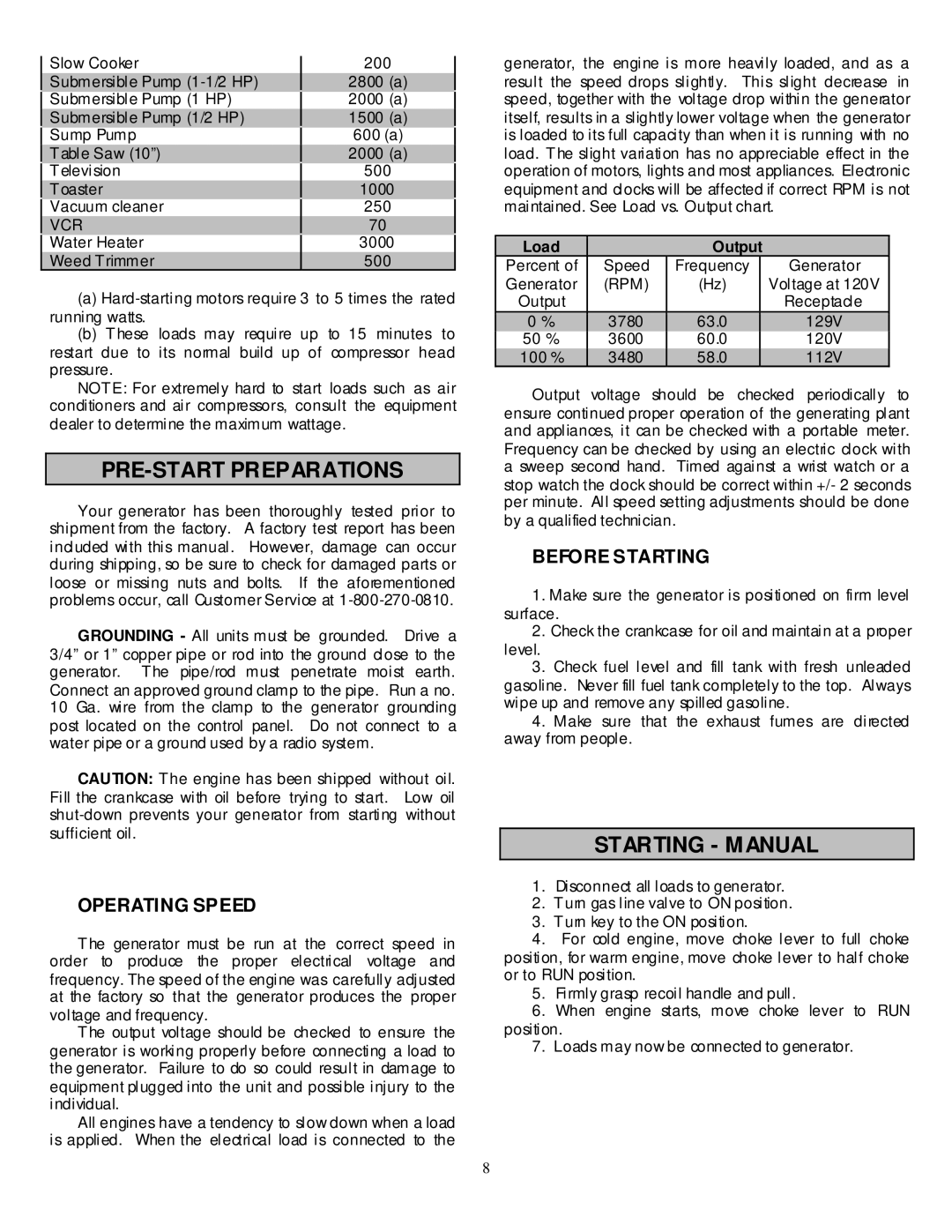
| Slow Cooker |
| 200 |
|
|
|
| ||
| Submersible Pump |
| 2800 (a) |
|
| Submersible Pump (1 HP) |
| 2000 (a) |
|
| Submersible Pump (1/2 HP) |
| 1500 (a) |
|
| Sump Pump |
| 600 (a) |
|
| Table Saw (10”) |
| 2000 (a) |
|
| Television |
| 500 |
|
| Toaster |
| 1000 |
|
| Vacuum cleaner |
| 250 |
|
| VCR |
| 70 |
|
| Water Heater |
| 3000 |
|
| Weed Trimmer |
| 500 |
|
(a)
(b)These loads may require up to 15 minutes to restart due to its normal build up of compressor head pressure.
NOTE: For extremely hard to start loads such as air conditioners and air compressors, consult the equipment dealer to determine the maximum wattage.
PRE-START PREPARATIONS
Your generator has been thoroughly tested prior to shipment from the factory. A factory test report has been included with this manual. However, damage can occur during shipping, so be sure to check for damaged parts or loose or missing nuts and bolts. If the aforementioned problems occur, call Customer Service at
GROUNDING - All units must be grounded. Drive a 3/4” or 1” copper pipe or rod into the ground close to the generator. The pipe/rod must penetrate moist earth. Connect an approved ground clamp to the pipe. Run a no. 10 Ga. wire from the clamp to the generator grounding post located on the control panel. Do not connect to a water pipe or a ground used by a radio system.
CAUTION: The engine has been shipped without oil. Fill the crankcase with oil before trying to start. Low oil
OPERATING SPEED
The generator must be run at the correct speed in order to produce the proper electrical voltage and frequency. The speed of the engine was carefully adjusted at the factory so that the generator produces the proper voltage and frequency.
The output voltage should be checked to ensure the generator is working properly before connecting a load to the generator. Failure to do so could result in damage to equipment plugged into the unit and possible injury to the individual.
All engines have a tendency to slow down when a load is applied. When the electrical load is connected to the
generator, the engine is more heavily loaded, and as a result the speed drops slightly. This slight decrease in speed, together with the voltage drop within the generator itself, results in a slightly lower voltage when the generator is loaded to its full capacity than when it is running with no load. The slight variation has no appreciable effect in the operation of motors, lights and most appliances. Electronic equipment and clocks will be affected if correct RPM is not maintained. See Load vs. Output chart.
Load |
|
| Output |
|
| |
Percent of | Speed |
| Frequency |
| Generator |
|
Generator | (RPM) |
| (Hz) |
| Voltage at 120V |
|
Output |
|
|
|
| Receptacle |
|
0 % | 3780 |
| 63.0 |
| 129V |
|
50 % | 3600 |
| 60.0 |
| 120V |
|
100 % | 3480 |
| 58.0 |
| 112V |
|
Output | voltage | should be checked periodically to | ||||
ensure continued proper operation of the generating plant and appliances, it can be checked with a portable meter. Frequency can be checked by using an electric clock with a sweep second hand. Timed against a wrist watch or a stop watch the clock should be correct within +/- 2 seconds per minute. All speed setting adjustments should be done by a qualified technician.
BEFORE STARTING
1.Make sure the generator is positioned on firm level surface.
2.Check the crankcase for oil and maintain at a proper
level.
3.Check fuel level and fill tank with fresh unleaded gasoline. Never fill fuel tank completely to the top. Always wipe up and remove any spilled gasoline.
4.Make sure that the exhaust fumes are directed away from people.
STARTING - MANUAL
1.Disconnect all loads to generator.
2.Turn gas line valve to ON position.
3.Turn key to the ON position.
4.For cold engine, move choke lever to full choke
position, for warm engine, move choke lever to half choke or to RUN position.
5.Firmly grasp recoil handle and pull.
6.When engine starts, move choke lever to RUN
position.
7. Loads may now be connected to generator.
8
